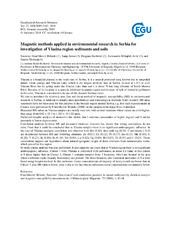Приказ основних података о документу
Magnetic methods applied in environmental research in Serbia for investigation of Vlasina region sediments and soils
| dc.creator | Frančišković-Bilinski, Stanislav | |
| dc.creator | Sakan, Sanja | |
| dc.creator | Đorđević, Dragana | |
| dc.creator | Mihajlidi-Zelić, Aleksandra | |
| dc.creator | Škrivanj, Sandra | |
| dc.date.accessioned | 2023-11-20T11:03:19Z | |
| dc.date.available | 2023-11-20T11:03:19Z | |
| dc.date.issued | 2019 | |
| dc.identifier.uri | https://meetingorganizer.copernicus.org/EGU2019/EGU2019-2182.pdf | |
| dc.identifier.uri | https://cer.ihtm.bg.ac.rs/handle/123456789/6854 | |
| dc.description.abstract | Vlasina is a beautiful plateau in the south-east of Serbia. It is a natural protected area, known due to unspoiled nature, clean springs and Vlasina Lake, which is the largest artificial lake in Serbia, located at 1.213 m a.s.l. Vlasina River has its spring under the Vlasina Lake dam and it is about 70 km long tributary of South Morava River. Because of its location in a sparsely inhabited mountain region and because of lack of industrial pollutants in this area, Vlasina is considered to be one of the cleanest Serbian rivers. We aim to introduce the relatively new, fast and cheap method of magnetic susceptibility (MS) in environmental research in Serbia, in addition to usually used geochemical and mineralogical methods. Until recently MS measurements have not been used for this purpose in the broader region around Serbia, e.g. first such measurements in Croatia were performed by Francišković-Bilinski (2008) on the samples from Kupa River watershed. ´ Measured MS values in Vlasina samples are mostly very low, with several locations where values are a bit higher; they range from 0.02 x 10-3 to 1.113 x 10-3 SI units. Statistical boxplot analysis of anomalies has shown that 3 extremes (anomalies of higher degree) and 1 outlier (anomaly of lower degree) exist. Correlation analysis between MS and measured chemical elements has shown that strong correlations do not exist. From that it could be concluded that in Vlasina samples there is no significant anthropogenic influence. In the case of Vlasina strongest correlation was observed with Mo (0.43), then with Ag (0.29). Correlations > 0.10 are determined between MS and following elements: Zn (0.17); Cu (0.12); Pb (0.17); Ba (0.13); Mn (0.10); Ti (0.20); V (0.21); In (0.16); Sn (0.16); Tm (0.10); Lu (0.12); Hg (0.16); Bi (0.13); Th (0.15) and U (0.24). Those correlations support our hypothesis about natural (geogene) origin of those elements from metamorphic rocks, which prevail in this region. Q-mode cluster analysis was also performed. It also supports our claim that in Vlasina region there is no significant anthropogenic influence. Cluster 1 from Vlasina is correlated with carbonates, as mean Ca value in this cluster is 8 times higher than in Cluster 2. Cluster 1 contains samples from 4 locations, which are located in the area where carbonate rocks (mainly limestones) are present. On those locations also statistical anomalies of Ca were found using boxplot method. In this carbonate cluster concentrations of majority of heavy metals are lower than in Cluster 2, also MS value is lower, what is due to the fact that in carbonates metal concentrations are naturally lower. | sr |
| dc.language.iso | en | sr |
| dc.publisher | Copernicus Publications | sr |
| dc.rights | openAccess | sr |
| dc.rights.uri | https://creativecommons.org/licenses/by/4.0/ | |
| dc.source | Geophysical Research Abstracts | sr |
| dc.subject | magnetic susceptibility | sr |
| dc.subject | environmental research | sr |
| dc.title | Magnetic methods applied in environmental research in Serbia for investigation of Vlasina region sediments and soils | sr |
| dc.type | conferenceObject | sr |
| dc.rights.license | BY | sr |
| dc.rights.holder | The Authors | sr |
| dc.citation.volume | 21 | |
| dc.citation.spage | EGU2019-2182 | |
| dc.description.other | European Geosciences Union (EGU) General Assembly 2019, Vienna, Austria, April 7-12, 2019 | sr |
| dc.identifier.rcub | https://hdl.handle.net/21.15107/rcub_cer_6854 | |
| dc.identifier.fulltext | http://cer.ihtm.bg.ac.rs/bitstream/id/27405/2019_EGU-2182.pdf | |
| dc.type.version | publishedVersion | sr |


